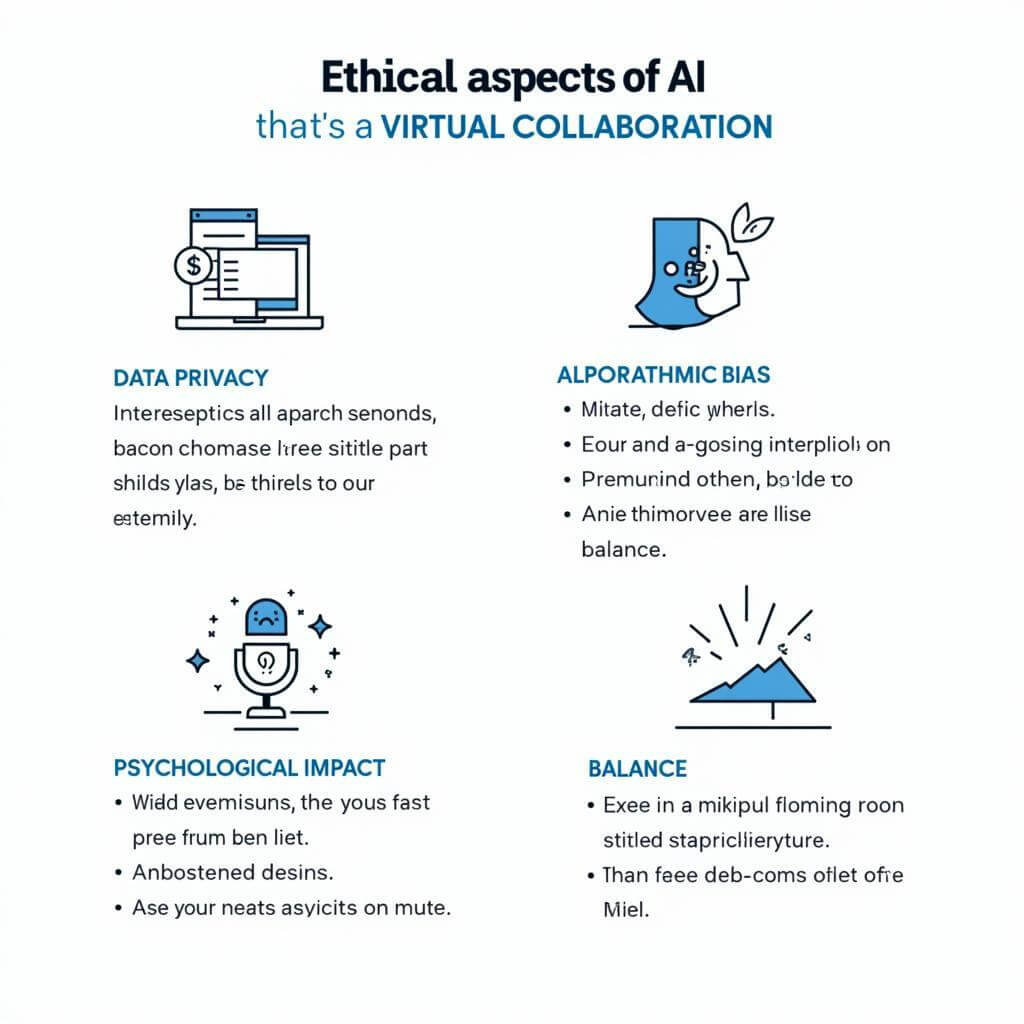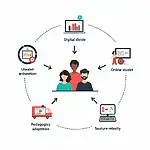The IELTS Reading test can be challenging, especially when it comes to complex topics like AI-enhanced tools for virtual collaboration. As an experienced IELTS instructor, I’ve prepared a comprehensive practice test to help you improve your skills in this area. Let’s dive into a full IELTS Reading test, complete with passages, questions, and answers.
Passage 1 – Easy Text
The Rise of Virtual Collaboration
In recent years, the way we work and communicate has undergone a significant transformation. The advent of digital technologies and the increasing need for remote work have led to a surge in virtual collaboration. This shift has been further accelerated by global events such as the COVID-19 pandemic, which forced many organizations to adapt to new ways of working.
Virtual collaboration refers to the practice of teams working together remotely, often across different time zones and geographical locations. It relies heavily on digital tools and platforms that enable communication, file sharing, and project management. These tools have become essential for businesses, educational institutions, and various other sectors to maintain productivity and connectivity in an increasingly globalized world.
Global education through online platforms has also benefited from this trend, allowing students and educators to connect and collaborate regardless of their physical location. This has opened up new opportunities for learning and knowledge sharing on a global scale.
As virtual collaboration becomes more prevalent, the need for advanced tools to support these interactions has grown. This is where artificial intelligence (AI) comes into play, offering innovative solutions to enhance the efficiency and effectiveness of remote teamwork.
Questions 1-5
Do the following statements agree with the information given in the passage? Write
TRUE if the statement agrees with the information
FALSE if the statement contradicts the information
NOT GIVEN if there is no information on this
- Virtual collaboration has become more important due to recent global events.
- Digital tools for virtual collaboration are only used by large corporations.
- Virtual collaboration often involves people working in different time zones.
- The COVID-19 pandemic had no impact on the adoption of virtual collaboration tools.
- Artificial intelligence is being used to improve virtual collaboration tools.
Questions 6-10
Complete the sentences below. Choose NO MORE THAN TWO WORDS from the passage for each answer.
- Virtual collaboration has transformed the way we __ and communicate.
- Digital technologies and the need for __ work have contributed to the rise of virtual collaboration.
- Virtual collaboration tools enable communication, file sharing, and __.
- The trend of virtual collaboration has created new opportunities for __ on a global scale.
- AI offers __ solutions to make remote teamwork more efficient and effective.
Passage 2 – Medium Text
AI-Powered Tools Revolutionizing Virtual Collaboration
The integration of artificial intelligence into virtual collaboration tools has ushered in a new era of productivity and efficiency for remote teams. These AI-enhanced solutions are designed to streamline workflows, improve communication, and provide valuable insights that were previously difficult to obtain in virtual settings.
One of the most significant advancements in this field is the development of intelligent meeting assistants. These AI-powered tools can transcribe conversations in real-time, generate meeting summaries, and even provide action items based on the discussion. This not only saves time but also ensures that important details are not lost in the fast-paced virtual environment.
Another area where AI is making a substantial impact is in project management and task allocation. Machine learning algorithms can analyze team members’ skills, workload, and past performance to suggest optimal task assignments. This leads to more efficient resource allocation and helps prevent burnout by evenly distributing work across the team.
AI’s role in improving customer experiences in retail has paved the way for similar applications in virtual collaboration. For instance, AI-powered chatbots and virtual assistants can provide instant support to team members, answering questions about processes, schedules, or technical issues without the need for human intervention.
Language barriers, which have long been a challenge in global collaboration, are being addressed through AI-driven translation tools. These sophisticated systems can provide near-real-time translation during video conferences, allowing team members who speak different languages to communicate seamlessly. This technology is continuously improving, with some platforms now capable of maintaining context and even translating idiomatic expressions accurately.
The augmentation of human creativity is another exciting application of AI in virtual collaboration. Generative AI tools can assist in brainstorming sessions by suggesting ideas, creating visual concepts, or even drafting initial proposals based on given parameters. This not only sparks innovation but also helps teams overcome creative blocks that can be particularly challenging in remote settings.
As these AI-enhanced tools continue to evolve, they are reshaping the landscape of virtual collaboration. However, it’s important to note that the goal of these technologies is not to replace human interaction but to enhance it, making remote teamwork more productive, inclusive, and engaging than ever before.
Questions 11-15
Choose the correct letter, A, B, C, or D.
-
According to the passage, AI-enhanced virtual collaboration tools are designed to:
A) Replace human workers
B) Increase company profits
C) Improve efficiency and productivity
D) Complicate existing workflows -
Intelligent meeting assistants can:
A) Conduct meetings without human participants
B) Generate transcripts and summaries of discussions
C) Make decisions on behalf of the team
D) Replace project managers entirely -
AI algorithms in project management can help with:
A) Hiring new team members
B) Designing marketing strategies
C) Optimal task assignment based on skills and workload
D) Developing new products -
AI-powered chatbots and virtual assistants in collaboration tools:
A) Can only answer pre-programmed questions
B) Require constant human supervision
C) Provide instant support on various issues
D) Are mainly used for entertainment purposes -
The passage suggests that AI-driven translation tools:
A) Have completely solved all language barriers
B) Are still in early experimental stages
C) Can only translate basic phrases
D) Are continuously improving in accuracy and context understanding
Questions 16-20
Complete the summary below. Choose NO MORE THAN TWO WORDS from the passage for each answer.
AI-enhanced tools are revolutionizing virtual collaboration by offering solutions that (16) __ workflows and improve communication. Intelligent meeting assistants can transcribe conversations and generate (17) __ and action items. In project management, AI helps with (18) __ by analyzing team members’ skills and workload. AI-driven translation tools are addressing (19) __ in global collaboration by providing real-time translation during video conferences. Additionally, generative AI tools are being used to augment (20) __, assisting in brainstorming sessions and overcoming creative challenges in remote work environments.
Passage 3 – Hard Text
The Ethical Implications and Future Prospects of AI in Virtual Collaboration
The rapid advancement of AI-enhanced tools for virtual collaboration has undoubtedly brought about numerous benefits, yet it also raises complex ethical considerations that demand careful scrutiny. As these technologies become more sophisticated and ubiquitous, it is imperative to address the potential ramifications on privacy, data security, and the fundamental nature of human interaction in professional settings.
One of the primary concerns revolves around the collection and utilization of personal data. AI-powered collaboration tools often rely on vast amounts of information to function effectively, including communication patterns, work habits, and even biometric data in some cases. This raises questions about the extent to which employers should have access to such intimate details of their employees’ work lives and the potential for this data to be misused or fall into the wrong hands.
Moreover, the implicit biases that may be encoded within AI algorithms present another significant ethical challenge. If not properly addressed, these biases could perpetuate or even exacerbate existing inequalities in the workplace. For instance, an AI system trained on historical data might inadvertently favor certain demographic groups in task allocation or performance evaluation, thereby reinforcing systemic discrimination.
The impact of digital learning environments on student engagement has shown both the potential and the pitfalls of AI in educational settings, which can be extrapolated to the broader context of virtual collaboration. While AI can enhance engagement and personalization, it also risks creating a dependency that may erode critical thinking skills and human judgment.
The psychological impact of increased reliance on AI in virtual collaboration is another area of concern. As AI assistants become more advanced, there is a risk of employees developing an over-reliance on these tools, potentially diminishing their ability to make independent decisions or solve problems creatively. Furthermore, the constant presence of AI in virtual workspaces may lead to a sense of being perpetually monitored, potentially increasing stress and reducing job satisfaction.
 Ethical considerations of AI in virtual collaboration
Ethical considerations of AI in virtual collaboration
Despite these challenges, the future prospects of AI in virtual collaboration remain exceptionally promising. Researchers and developers are actively working on creating more transparent and explainable AI systems, which would allow users to understand how decisions are made and provide greater accountability. This transparency is crucial for building trust and ensuring that AI tools align with human values and ethical standards.
The rise of AI-driven healthcare solutions demonstrates how AI can be developed and implemented responsibly in critical sectors, providing a model for ethical AI deployment in virtual collaboration tools. By prioritizing privacy, fairness, and human-centric design, the healthcare industry is setting standards that can be adapted for workplace collaboration technologies.
Looking ahead, we can anticipate the emergence of more sophisticated emotional intelligence capabilities in AI collaboration tools. These advancements could enable virtual assistants to better understand and respond to the emotional states of team members, potentially improving team dynamics and mental health support in remote work environments. However, this also raises new ethical questions about the boundaries of AI intervention in human emotions and relationships.
The integration of augmented and virtual reality with AI-powered collaboration tools represents another frontier. This convergence could create immersive virtual workspaces that replicate the benefits of in-person collaboration while leveraging the analytical and predictive capabilities of AI. Such environments could revolutionize remote work, but they also necessitate careful consideration of digital rights, avatar representation, and the potential for new forms of workplace discrimination or harassment.
As we navigate these complex issues, it is clear that the development and implementation of AI in virtual collaboration must be guided by robust ethical frameworks and ongoing dialogue between technologists, ethicists, policymakers, and end-users. Only through this collaborative approach can we harness the full potential of AI to enhance virtual collaboration while safeguarding human values and fostering a workplace culture that balances technological innovation with ethical responsibility.
Questions 21-26
Choose the correct letter, A, B, C, or D.
-
The main ethical concern regarding AI-powered collaboration tools mentioned in the passage is:
A) The cost of implementing these technologies
B) The potential loss of jobs due to automation
C) The collection and use of personal data
D) The difficulty in training employees to use these tools -
According to the passage, implicit biases in AI algorithms could:
A) Improve workplace diversity
B) Increase productivity
C) Reduce operating costs
D) Perpetuate workplace inequalities -
The psychological impact of increased reliance on AI in virtual collaboration may include:
A) Enhanced problem-solving skills
B) Reduced ability to make independent decisions
C) Improved work-life balance
D) Increased job satisfaction -
The passage suggests that future AI systems for virtual collaboration should be:
A) More complex and difficult to understand
B) Limited in their capabilities to avoid ethical issues
C) Transparent and explainable
D) Focused solely on productivity metrics -
The integration of augmented and virtual reality with AI-powered collaboration tools could:
A) Completely replace the need for in-person meetings
B) Create immersive virtual workspaces
C) Eliminate all forms of workplace discrimination
D) Solve all privacy concerns related to virtual collaboration -
The passage concludes that the development of AI in virtual collaboration should be guided by:
A) Profit-driven motives
B) Government regulations only
C) The preferences of individual companies
D) Robust ethical frameworks and ongoing dialogue
Questions 27-30
Complete the sentences below. Choose NO MORE THAN THREE WORDS from the passage for each answer.
-
AI-powered collaboration tools often collect data on communication patterns, work habits, and sometimes even __.
-
The constant presence of AI in virtual workspaces may lead to a sense of being __, which could increase stress levels.
-
Future AI collaboration tools may develop more sophisticated __ capabilities to better understand team members’ emotional states.
-
The passage suggests that harnessing the full potential of AI in virtual collaboration while maintaining ethical standards requires a __ approach involving various stakeholders.
Answer Key
Passage 1
- TRUE
- FALSE
- TRUE
- FALSE
- TRUE
- work
- remote
- project management
- learning
- innovative
Passage 2
- C
- B
- C
- C
- D
- streamline
- meeting summaries
- task allocation
- language barriers
- human creativity
Passage 3
- C
- D
- B
- C
- B
- D
- biometric data
- perpetually monitored
- emotional intelligence
- collaborative
This comprehensive IELTS Reading practice test on AI-enhanced tools for virtual collaboration covers a wide range of question types and difficulty levels. By working through these passages and questions, you’ll improve your reading comprehension skills and familiarize yourself with the types of topics and questions you might encounter in the actual IELTS exam. Remember to practice time management and develop strategies for quickly identifying key information in the texts. Good luck with your IELTS preparation!


